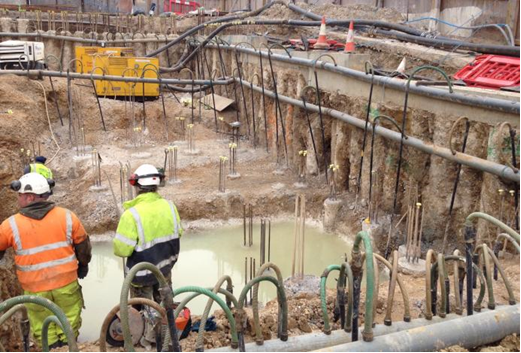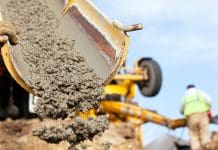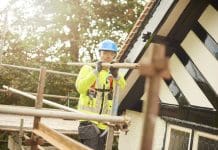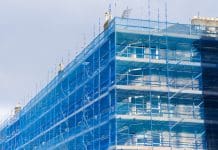James McDonald of Cementaid discusses the importance of waterproofing admixtures that also provide damp-proofing in achieving design intent
Previous articles frequently mentioned the British Standard BS 8102, code of practice for protection of below ground structures against water from the ground. The 2009 revision of this standard has introduced the concept that “a waterproofing specialist should be included as part of the design team so that an integrated waterproofing solution is created”.
It does not state what qualifications such a person must have but merely that the person must be suitably experienced, capable of devising solutions and provide the design team with information and guidance that assists with the design, installation and future maintenance of the waterproofed structure.
The only organisation in the UK that has a specific relevant qualification is the Property Care Association, who provide training and exams to those wishing to become a Certificated Surveyor in Structural Waterproofing (CSSW). However, other professionals with relevant experience could also be considered as suitably qualified to be the design team’s waterproofing specialist, eg an architect or structural engineer.
In terms of housebuilding, defects insurers such as the NHBC require a report from a waterproofing expert where there is a basement. They expect the expert to be able to prove her/his credentials as acceptable and to hold adequate professional indemnity (PI) insurance.
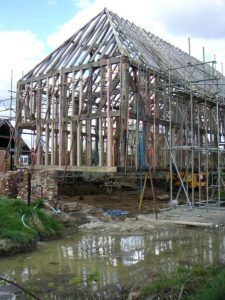 The experts report needs to carefully consider the contents of BS 8102, which neatly takes one through the waterproofing design process. This starts with a desk study looking at the geotechnical report, the topography of the site and surrounding ground and whether there are any ground gases or contaminants that need to be dealt with.
The experts report needs to carefully consider the contents of BS 8102, which neatly takes one through the waterproofing design process. This starts with a desk study looking at the geotechnical report, the topography of the site and surrounding ground and whether there are any ground gases or contaminants that need to be dealt with.
This is followed by a risk assessment, which should include an assessment of the basement usage and customer’s expectation. The standard identifies three grades of basement dependant on usage. Grade 1 is usually car parking where some seepage and damp areas may be acceptable but drainage may be needed for the seepage. Grade 2 is generally plant rooms with electrical equipment that requires a higher level of protection against water ingress than Grade 1, so no water seepage but damp areas may be tolerable. Finally, Grade 3, usually habitable residential or commercial areas where no water penetration is acceptable and the area should have ventilation, dehumidification or air conditioning appropriate for intended use.
Dependent on the outcome of the risk assessment, BS 8102 recommends the use of two waterproofing systems in more critical cases. The methods of waterproofing are split into three categories: Type A is for barrier systems, eg membranes, Type B is for reinforced concrete or structural steel and Type C is drained protection. Where two systems are to be used, they must be of different ‘types’. The design intent here is admirable but to many this is an extra expense, so it is important to remember that the use of two cheap systems is unlikely to achieve the intended result.
Many people cite the Outwing v Thomas Weatherald case of 1999 for the reason why the 2009 revision of BS 8102 includes the principle of considering the use of two types of waterproofing. This case involved a property tanked externally using a bonded sheet membrane which failed, allowing water penetration. The contractor, Outwing, was found not to be liable because the problem was caused by design failure, not workmanship. The court held that for a tanking system to work when water pressure came to bear, it would have to be defect-free, which the court held as neither reasonable nor realistic.
The walls were constructed out of two skins of concrete block, sandwiching a layer of concrete in between. Even if the concrete had been reinforced, I do not think that this would comply with the requirements for Type B waterproofing. However, a land drain was positioned approximately one-third of the way up the wall and discharged to a soakaway a little distance from the building. In general, such land drains should be positioned below the basement slab level to prevent water perching against the membrane.
BS 8102 highlights three very important considerations that are critical to the waterproofing design.
The first is ‘buildability’. If something is difficult or problematical to install, it will have a very high possibility of failure. Second is ‘repairability’. Nothing is 100% foolproof, so you need to consider how repairs will be carried out.
Thirdly, ‘sustainability’. At the end of the structure’s life, how will the materials used for the waterproofing be disposed of?
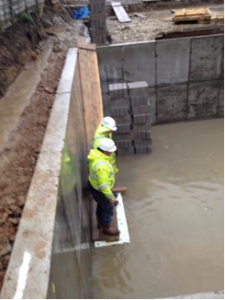 So where do waterproofing admixtures fit into BS 8102? They are part of the Type B protection. However, as the standard points out, there are a number of such admixtures on the market and the choice for specification depends on assessment and certification of the chosen product.
So where do waterproofing admixtures fit into BS 8102? They are part of the Type B protection. However, as the standard points out, there are a number of such admixtures on the market and the choice for specification depends on assessment and certification of the chosen product.
Waterproofing basement structures will never be a simple process, as can be seen from the photo inset of a building being redeveloped to include a habitable basement!
Of course, “design intent” is all very well until contractors decide to do some ‘value engineering’ but this has recently been the subject of a legal case which has caused some alarm. Indeed, so shocking was the decision that the national president of the Australian Institute of Architects suggested in an email to members that they might need to seek counselling.
A warning to specifiers who agree to a change in their specification
Earlier this year, the Victorian Civil & Administrative Tribunal (VCAT) ordered the owners of the high-rise Lacrosse Building in the Melbourne Docklands precinct to be immediately paid A$5.7m in damages. The judge also indicated that the owners would receive most of the balance of their A$12.7m claim – including nearly A$6m in calculated costs of compliance with building codes.
The case involved a serious cladding fire in November 2014, started by a single cigarette on a balcony. The cladding used on the outside of the building, known as Alucobest, was found to have been highly flammable and did not comply with Australian building standards.
The tribunal heard that a product “indicative to Alucobond” had been specified for the project in 2009 but the Alucobond range at the time included one product with a polyethylene core, which is combustible, and two with a non-combustible mineral core.
Callum Fraser for the architects Elenberg Fraser gave evidence that “it was for the builder to decide which product to choose” but that in his view the contractor should have chosen Alucobond Plus, which has a mineral core.
The tribunal also heard that a sample of an alternative product, the non-compliant Alucobest, had been brought to Elenberg Fraser for inspection, who approved it. The architect submitted that under its contractual obligation samples were reviewed for “visual characteristics only”.
The judge rejected this submission. He said: “The provision of the Alucobest sample to Elenberg Fraser for inspection presented it with a clear opportunity as head design consultant to ensure that its design intent reflected in the Alucobond Specification, was fulfilled.”
The judge found “Elenberg Fraser breached its Consultant Agreement by failing to exercise due care and skill in failing as head design consultant to ensure that the sample provided by the contractor was compliant with Elenberg Fraser’s design intent”.
As a result of this judgement, the emphasis now is more clearly focused on what the Victorian Civil & Administrative Tribunal (VCAT) judge referred to as the “design intent” of a particular specification or specified material, rather than on the use or otherwise of a specific material per se, or even the properties of those materials.
So if there is reliance on the concrete to provide waterproofing, the design intent must surely be to have dry concrete, especially if the ground or groundwater contains contaminants that can cause serious damage to concrete, for example sulfate or salt. However, ordinary concrete is highly porous, so an appropriate waterproofing admixture that also provides damp-proofing will be needed to achieve this design intent.
James McDonald
General Manager
Cementaid
Tel: +44 (0)1293 653 900
Twitter: @Cementaid_Sales


